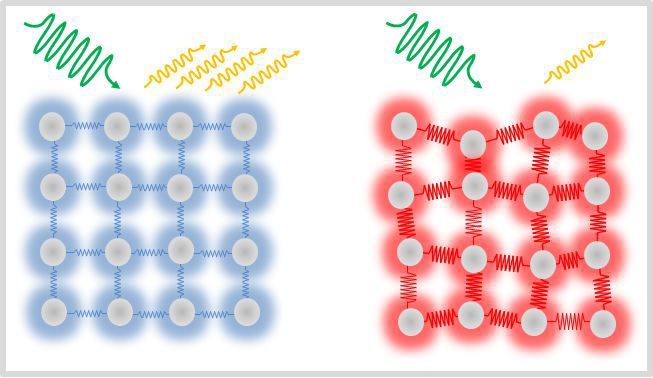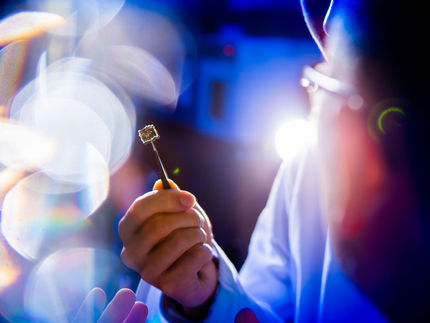Utrafast magnetism: electron-phonon interactions examined at BESSY II
How fast can a magnet switch its orientation and what are the microscopic mechanisms at play ? These questions are of first importance for the development of data storage and computer chips. Now, an HZB team at BESSY II has for the first time been able to experimentally assess the principal microscopic process of ultra-fast magnetism. The methodology developed for this purpose can also be used to investigate interactions between spins and lattice oscillations in graphene, superconductors or other (quantum) materials.

When illuminated by the synchrotron light, nickel emits x-rays itself due to the decay of valence electrons. The number of emitted photons reduces when increasing the temperature from room temperature (left) to 900°C (right).
HZB
Interactions between electrons and phonons are regarded as the microscopic driving force behind ultrafast magnetization or demagnetization processes (spin-flips). However, it was not possible until now to observe such ultrafast processes in detail due to the absence of suitable methods.
Original new method at BESSY II
Now, a team headed by Prof. Alexander Föhlisch has developed an original method to determine experimentally for the first time the electron-phonon driven spin-flip scattering rate in two model systems: ferromagnetic Nickel and nonmagnetic copper.
They used X-ray emission spectroscopy (XES) at BESSY II to do this. X-rays excited core electrons in the samples (Ni or Cu) to create the so-called core-holes, which were then filled by the decay of valence electrons. This decay results in the emission of light, which can then be detected and analyzed. The samples were measured at different temperatures to observe the effects of lattice vibrations (phonons) increasing from room temperature to 900 degrees Celsius.
In Nickel: Emissions decrease when the sample is hot
As the temperature increased, ferromagnetic nickel showed a strong decrease in emissions. This observation fits well with the theoretical simulation of processes in the electronic band structure of nickel after excitations: by increasing the temperature and thus, the phonon population, the rate of scattering between electrons and phonons increases. Scattered electrons are no more available for decay, which results in a waning of the light emission. As expected, in the case of diamagnetic copper, the lattice vibrations had hardly any influence on the measured emissions.
"We believe that our article is of high interest not only to specialists in the fields of magnetism, electronic properties of solids and X-ray emission spectroscopy, but also to a broader readership curious about the latest developments in this dynamic field of research," says Dr. Régis Decker, first author and postdoctoral scientist in the Föhlisch team. The method can also be used for the analysis of ultrafast spin flip processes in novel quantum materials such as graphene, superconductors or topological insulators.
Original publication
Other news from the department science
Most read news
More news from our other portals
See the theme worlds for related content
Topic World Spectroscopy
Investigation with spectroscopy gives us unique insights into the composition and structure of materials. From UV-Vis spectroscopy to infrared and Raman spectroscopy to fluorescence and atomic absorption spectroscopy, spectroscopy offers us a wide range of analytical techniques to precisely characterize substances. Immerse yourself in the fascinating world of spectroscopy!

Topic World Spectroscopy
Investigation with spectroscopy gives us unique insights into the composition and structure of materials. From UV-Vis spectroscopy to infrared and Raman spectroscopy to fluorescence and atomic absorption spectroscopy, spectroscopy offers us a wide range of analytical techniques to precisely characterize substances. Immerse yourself in the fascinating world of spectroscopy!






























































